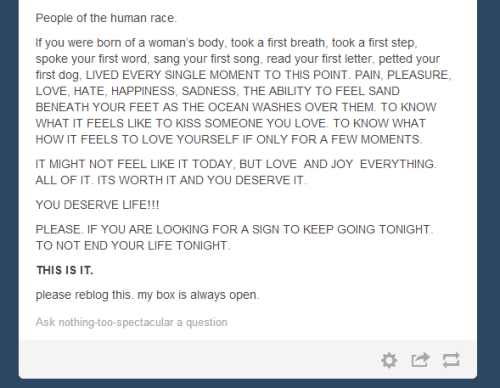
Catholic. Pro-life. Amateur seamstress. Neurodivergent. Latin student.
148 posts
Latest Posts by thecatholicseamstress - Page 2


CINDERELLA 2015 ― Dir. Kenneth Branagh

Likes to charge reblogs to FUCKING cast
19 years?! Girl, who are you dating, Nathan Detroit?
Abstinence education MUST be based on a foundation of respect for self and others, and a sense of responsibility towards sex and how it can affect you and others. It can NOT be based on fear of sex, making sex an activity that “dirties” you, or something that turns virginity into a prize that makes you “pure.”

Happy antigone buried alive friday
Just a quick and gentle reminder that it is never, ever okay to wish harm, destruction, and death upon people.
Ever.
A dead body was found on lake Michigan, please pray for his soul. Thank you

What I’m wearing
im inviting u all to my wedding btw
Reblog to hug prev poster (they need a hug)
hating women is satan worship
I think we all need some soup right now. Reblog to give prev a bowl of their favourite soup.
religion to women: you need to be servants >:(
religion to m*n: you deserve servants :D

you should drop the cannabalism and violence as a form of love thing. have you tried hugs and kisses
If you'd like to, reblog this post if you're a practicing Christian




Share. Please. In honor or this nameless hero whom because of this letter he or she sent me, could save a life tonight.
again, my box is always open.


Latachie “The Invisible Girl” Veal, 17 (USA 1991)
Houston teenager Latachie Veal was 20–22 weeks pregnant when she suffered a painful death at the hands of the West Loop abortion facility staff.
Latachie was already bleeding badly at the abortion facility and crying out for help. The staff dismissed her bleeding and excruciating pain as “normal” and sent her home. Hours later, Latachie stopped breathing. Her terrified sister administered CPR while a brother-in-law called 911, but Latachie was dead on arrival at Ben Taub Hospital. She was only 17.
Her furious and heartbroken family sued Robert Crist, the abortionist who killed Latachie and her baby. He had already been the subject of a lawsuit over the abortion death of 19-year-old Diane Boyd, a disabled victim of forced abortion. Crist was also sued for the case of an abortion client who delivered her baby’s mutilated corpse in a bathroom two days after the abortion. And just a few weeks before killing Latachie, another teenage girl had been hospitalized for abortion injuries inflicted by West Loop. Crist should never have been allowed to keep his license long enough to kill Latachie.
Crist appeared on TV calling the case “media hype” and a “political event”. The Veal family’s attorney responded, "I wish he would have a copy of the 911 tape.... If he would talk to the parents, if he would talk to the sister as she gave her CPR or talk to the brother-in-law as she was breathing her last breath and see then if he thinks it's a media event."
To add insult to lethal injury, Latachie’s death was excluded from CDC data on deaths from legal abortion. Even though her case went public and was documented in newspapers and court records, the voluntary-only reporting system for abortion deaths clearly was not enough for the CDC to notice. Data sets from the CDC on deaths from legal abortion counted NO abortion fatalities in Black girls aged 15–19 in 1991. This exclusion has earned Latachie the nickname “Invisible Girl” among some researchers because apparently nobody at the CDC noticed her death.
This is even more astounding when you take into account the speech Crist made at the 1992 National Abortion Federation Seminar in Dallas. He openly spoke about Latachie’s death and tried to convince his audience that the death was not his fault. (He did not, of course, mention her name, but researchers were unable to find any another 17-year-old abortion client of his who he killed in 1991.) TWO staffers from the Centers for Disease Control's abortion surveillance activities area attended, including the person whose job it was to verify abortion deaths. Yet Latachie still went uncounted.
In spite of all the publicity, in spite of the lawsuit, in spite of the shouting from the rooftops, in spite of the abortionist discussing her death at an event attended by the very woman whose job it was to notice abortion deaths, the Centers for Disease Control failed to notice Latachie. Their 1991 Abortion Surveillance Report, published in May of 1995, did not even mention of abortion mortality and requests for information had to be filed to even see the statistics, which still did not include Latachie. If the CDC failed to notice Latachie’s highly-publicized death even after it was discussed openly at an event attended by two of their abortion surveillance staffers, what would it take to get them to notice and count legal abortion deaths?
Two months after Latachie was killed, another 17-year-old girl had to be hospitalized for abortion injuries inflicted at the West Loop facility. Both young girls deserved better than abortion.


"Death of teen after abortion leads to probe of care at medical clinic," Houston Chronicle, November 6, 1991
"Secrecy veils state probes of abortion clinics," Houston Chronicle, February 9, 1992
Houston Chronicle 11-3-91, 11-11-91
Houston Post 11-7-91, 11-12-91
Washington Times 11-21-91
i am FULLY against the sentiment that we don’t owe anybody anything. we owe people common decency. we owe people respect if it has been given to us. we owe people apologies & explanations when we hurt them. i don’t care.
The first funny bitch was Cain, who straight up lied to God after killing his brother.
Happy All Saint's Day!
Honestly, the problem isn't even with the raisins themselves. The problem is that you usually think you're getting a chocolate chip cookie.
Since it seems to be starting discourse with my moots, I'm curious now:
Please reblog so more people can weigh in lmao.
reblog if you need a hug
Reblog this to place a small flower in the hair of prev, and that you're very proud of them
Something I've noticed with booktok is that at the same time as the rise of bad reading habits like only reading stuff with spice or skipping long paragraphs there's also the rise of an almost veneration of the physical book, like people getting really upset over dog-earring pages or cracking the spine. There's probably a poem in here somewhere but I'm too tired to find it.

repost if you're not ashamed of the gospel of jesus christ

thinking about the infantiliztation and/or formalization of 19th-century women's clothing to modern audiences
like
our entire reference point for "wearing long skirts and outfits with decoration like lace, embroidery, appliques, etc." is either formalwear or fictional characters in children's media like Disney princesses. women's clothing is just so radically different now- not that those elements don't exist, but they're much less common in everyday clothing than they once were. some form of simple trousers and an equally simple top are de rigeur for everyday attire, and anything else is Fancy
combined with the fact- which is true! -that a lot of what survives to end up in big museums belonged to wealthy people, this ends up in wild assumptions like "basically our entire idea of what the Victorians dressed like is just Rich People Clothes really"
which has led to the eternal cry of "but what did NORMAL people wear?!?!?!" that will not be satisfied with real examples of middle or even working-class everyday clothing because it still looks too "fancy" to modern eyes
not Victorian, but a great example of this is what Abby Cox wore to portray a milliner (hatmaker) in Colonial Williamsburg. a working, middle-class woman:

(ignore the facial expression there)
this is the exact outfit she sported in a video that apparently got responses like "but that's just what rich women wore!" and it is, in fact, everyday attire for a working person. a person who worked in the fashion industry, it's true, but still
I had someone ask me about how to find examples of casual Victorian clothing because they were at their wits' end trying to research it. and I had to tell them that...what they were looking at WAS casual. in the sense of Clothing For Everyday Wear That's Not Especially Formal. there's nothing inherently formal, or exclusive to the wealthy, about a matched bodice-and-skirt dress, instep-length, with some trim. or even a trimmed blouse and skirt. obviously women working the absolute hardest outdoor, physical jobs might have adopted occupational trousers or similar, but we don't all dress like construction or farm workers all the time nowadays. why would they have back then?

Laundresses, probably 1850s or early 60s. Note that I can STILL date the picture based on their outfits and hair, and these are the furthest things from wealthy socialites.

Maid scrubbing steps, probably 1870s or 1880s. Note pleated trim on her skirt and what appears to be a peplum at the back of her bodice.
also, not all working women worked physical jobs any more than we do today. here is a teacher around the turn of the 20th century:


Teachers, 1887

"Breton Seamstresses," 1845, by Jules Trayer
were there differences in quality, type and quantity of trim, fit, etc? obviously. but some people are convinced that the basic outfit format can't POSSIBLY have been something ordinary women wore, because it looks formal and/or princess-y in a modern context
